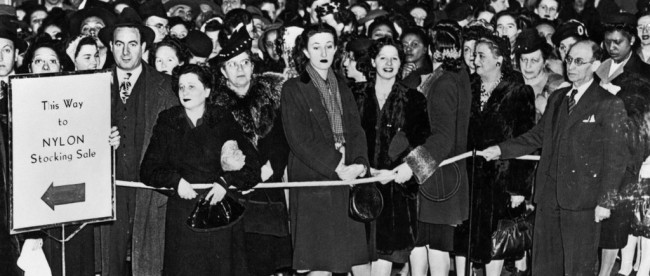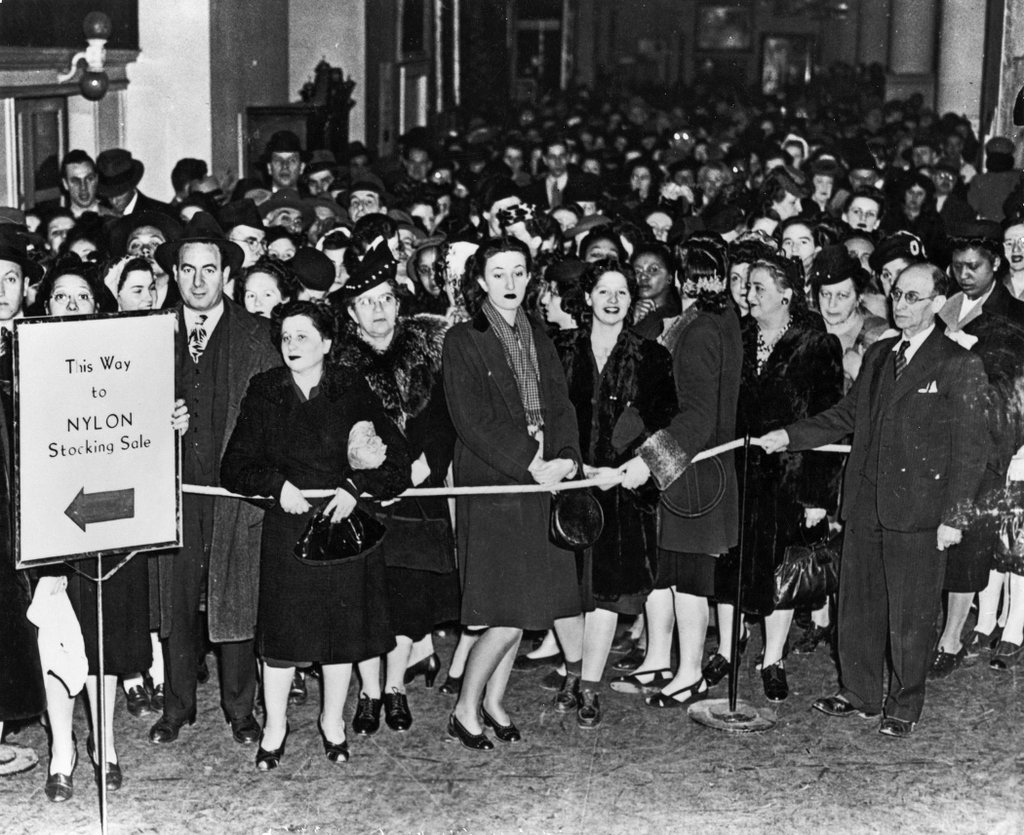A Run on Nylons


In April of 1939, DuPont Chemical introduced nylon stockings to the world at the World’s Fair in New York City. The marketing was ambitious — as the New York Times reported, DuPont had a model named Miss Chemistry “emerg[e] from a test tube, her legs coated in a polymer boasting futuristic properties: ‘filaments as strong as steel, as fine as a spider’s web, yet more elastic than any of the common natural fibers.’” That October, the company began selling nylon stockings for about $1.25 a pair — twice the price of silk ones — and despite the seemingly exorbitant price, the product was almost instantly popular. Within two years, nylon — the first man-made fiber — accounted for 30% of the U.S. stocking market.
But then, nylon stockings disappeared from stores throughout the country. As the Los Angeles Times recounted, after the United States entered World War II, “nylon was classified as an essential material, to be manufactured exclusively for military applications such as parachute cloth, ropes and tent fabric.” Hosiery? Not essential for beating the Axis. Supply evaporated but demand remained high — per some reports, there was even a black market for nylons, with prices hitting $20 a pair. (Wikipedia, but alas without a cite to a primary source, goes one further: “Because nylon was so widely sought-after, it also became the target of crime. In Louisiana, one household was robbed of 18 pairs of nylons. Similarly, robbery was ruled out as the motive of a murder in Chicago because the nylons were untouched.”)
When World War II came to a close in 1945, DuPont shared some good news with its would-be customers: nylon stockings were coming back. On August 22, just days after the Japanese surrendered, DuPont announced that it would switch product back to “peace time applications” and, per the book “Popular Ideologies: Mass Culture at Mid-Century,” promised to “make enough yarn for ‘360,000,000 pairs [of nylon stockings] in a year — 11 pairs for each woman in America.’” Unfortunately, that estimate proved to be wildly inaccurate. Shortages were the norm, but demand stayed high. As a result, when a retailer announced they had nylons in stock, women would queue up well in advance, and in huge numbers, for the chance to buy some stockings. Here’s some photographic evidence:

That picture is from an announced sale of nylons in Pittsburgh in June of 1946. Per various reports, roughly 40,000 women lined up to buy stockings — to find that only 13,000 nylons were up for sale. While the crowd was generally peaceful, some arguments broke out; the book “Nylon: The Story of a Fashion Revolution” relays a report from a local newspaper claiming that “a good old-fashioned hair-pulling, face-scratching fight broke out in the line.” And this wasn’t something specific to Pittsburgh; long lines, short supplies, and often shorter tempers were the norm throughout the nation. The phenomenon began known as the “Nylon Riots.”The nylon-driven mob scenes came to an end in late 1946. DuPont was finally able to get production up and running again to full capacity, and it delivered upon its promise to produce enough nylon for 30 million pairs per month.
Bonus Fact: During the war, with nylons hard to come by, many women came up with a creative solution: leg makeup. The idea to simply shave one’s legs and then draw a fake seam up the back. Some salons even began to offer leg makeup as a service. Pictures of both the do-it-yourself method and the paid practice can be seen here.
From the Archives: The Last Straw: Riots over straw hats.
Take the Quiz: Name the words that have L-E-G in them.
Related: A nylon parachute. Probably not the type they used in World War II, but certainly a lot more fun.
